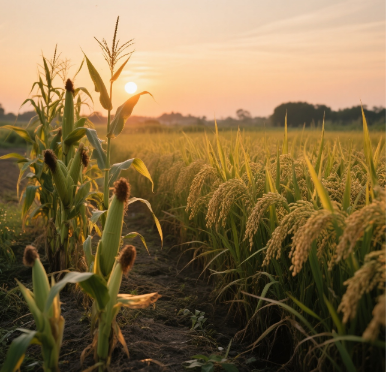Rice and corn form the foundation of China’s agricultural economy, serving as staple crops that ensure food security and generate rural income. However, the profitability of cultivating these crops depends on the interplay of various factors, including costs, yields, market dynamics, and policy support. This analysis explores the financial viability, risks, and long-term prospects of rice and corn farming in China.
Cost Structures: Rice vs. Corn (Per Mu, Equivalent to 0.067 Hectares)
Rice cultivation is labor- and resource-intensive, with significant cost components.
- Land rent: ¥300–1,200 per mu, varying widely by region (higher in developed agricultural regions).
- Seeds: ¥8–180/mu (Hybrid seeds are known for their higher yields but cost significantly more than traditional varieties).
- Fertilizers: ¥140–260/mu (including compound fertilizers and urea, which are essential for soil enrichment).
- Pesticides: ¥100–200/mu (depending on pest pressure; rice is susceptible to diseases such as rice blast).
- Irrigation: ¥50–200/mu (costs differ based on traditional flood irrigation versus modern water-saving systems).
- Machinery: ¥230–350/mu (for plowing, transplanting, and harvesting machinery).
Total cost range: ¥808–1,340/mu. These high costs reflect the intensive labor and resource requirements of rice cultivation.
In contrast, corn farming requires fewer resources, resulting in lower overall costs.
- Land rent: ¥300–1,000 per mu (slightly cheaper than rice, with regional variations).
- Seeds: ¥60–150/mu (cheaper than rice seeds).
- Fertilizers: ¥130–220/mu (includes nitrogen, phosphorus, and potassium blends).
- Pesticides: ¥30–80/mu (rice is more prone to pests).
- Irrigation: ¥30–80/mu (corn requires less water, reducing costs).
- Machinery: ¥150–240/mu for plowing, sowing, and harvesting equipment.
Total Cost Range: ¥670–1,070/mu. Although costs are lower, profitability depends on market prices and yield stability.
Revenue and profitability
Rice offers higher revenue potential, but with greater profit variation.
- Yield: 400–700 kg/mu.
- Market prices:
- Standard rice: ¥2–3/kg → ¥800–2,100/mu gross revenue.
- Premium rice (e.g., organic or fragrant varieties): ¥4–6/kg → significantly higher profits.
- Net profit: – ¥40 to ¥760/mu. Profits can turn negative if costs exceed revenue, but premium rice offsets high input costs.
Corn’s revenue is more stable, though lower.
- Yield: 300–600 kg/mu
- Price: ¥1.8–2.4/kg Gross revenue: ¥540–1,440/mu
- Net profit: – ¥130 to ¥770/mu. Lower costs mitigate risk, but price fluctuations impact profitability.
Key Cost-Related Insights:
- Rice’s higher costs: Land rent, hybrid seeds, and intensive irrigation increase expenses, but premium varieties can generate substantial profits.
- Corn’s efficiency: Lower input costs (especially for labor, pesticides, and water) make it less risky financially. However, its profit margin is narrower.
Market Dynamics and Risks
- Rice
- Stability: Government price supports and minimum purchase policies protect farmers from severe market downturns.
- Risks: Climate disasters (e.g., floods and droughts) and diseases (e.g., rice blast) can devastate yields, offsetting high costs.
- Corn:
-
- Demand Diversity: Use in food, animal feed, and biofuels ensures steady demand.
- Risks: Global trade policies (e.g., import tariffs) and domestic market shifts cause price volatility. Pests, such as corn borers, and weather extremes, such as hail, threaten harvests.
Long-Term Outlook: Opportunities and Strategies
- Rice: Focus on value-added approaches.
- Premium Markets: Demand for organic and specialty rice is growing, particularly in urban areas.
- Diversification: Rice-fish co-culture systems can increase income by ¥200–400/mu.
- Government Support: Subsidies for seeds, irrigation infrastructure, and machinery reduce upfront costs.
- Corn: Leverage expanding sectors:
- Industrial Demand: Ethanol production and livestock feed drive steady consumption.
- Contract Farming: Agreements with food processors or biofuel companies stabilize prices.
- Export Potential: China’s rising meat consumption is fueling demand for corn as animal feed and could open export markets.
Conclusion: Can Farmers Succeed?
Both crops offer pathways to profitability, but only if the right strategies are employed.
- Rice farming: It is profitable when high-value varieties are used, costs are managed efficiently, and access to government subsidies is available (average earnings: ¥0–760/mu).
- Corn farming: Lower costs, but more price sensitive. Success requires risk hedging through contracts (average earnings: ¥0–770/mu).
Key recommendations:
- Adopt high-yield seeds. Hybrid rice and pest-resistant corn varieties improve productivity and resilience.
- Embrace precision farming. Drip irrigation, soil sensors, and AI-driven pest monitoring can reduce costs by 15–20%.
- Explore niche markets. Premium rice brands and contract farming with processors can increase your profits.
- Diversify crops. Smallholders should grow rice and corn to balance risks (e.g., grow rice for stability and corn for efficiency).
Success hinges on efficient practices, market adaptability, and government support. Technological advancements, such as automated irrigation, and policy incentives will be pivotal in stabilizing incomes.
In China’s evolving agricultural landscape, farmers must navigate cost pressures, market volatility, and environmental risks. Aligning with high-value markets, adopting modern techniques, and diversifying production can help smallholders build sustainable livelihoods. Ultimately, profitability isn’t just about yields; it’s also about optimizing the cost-to-revenue ratio and hedging against uncertainty.









